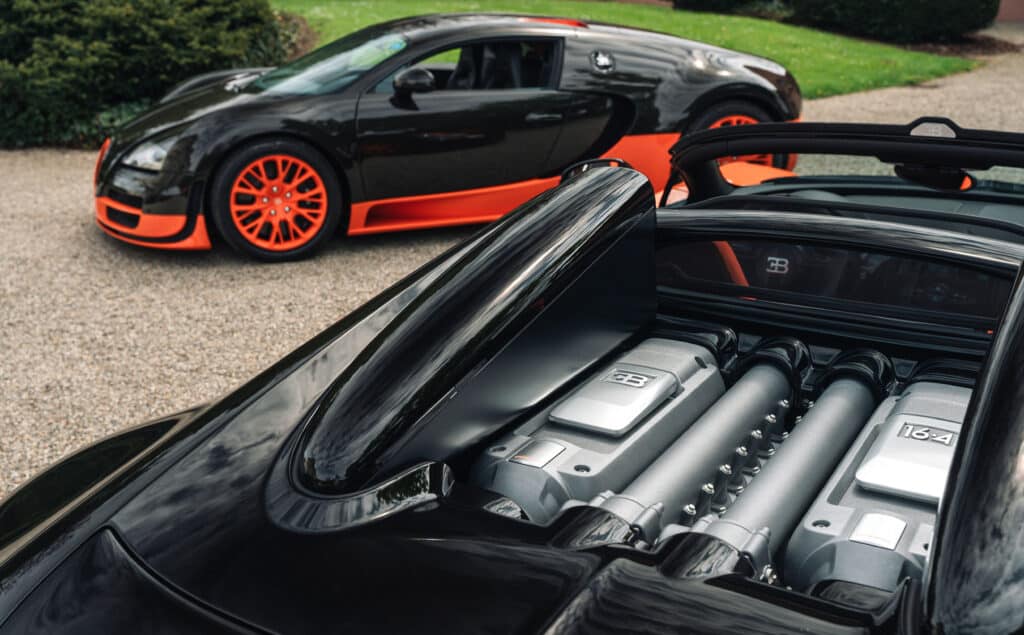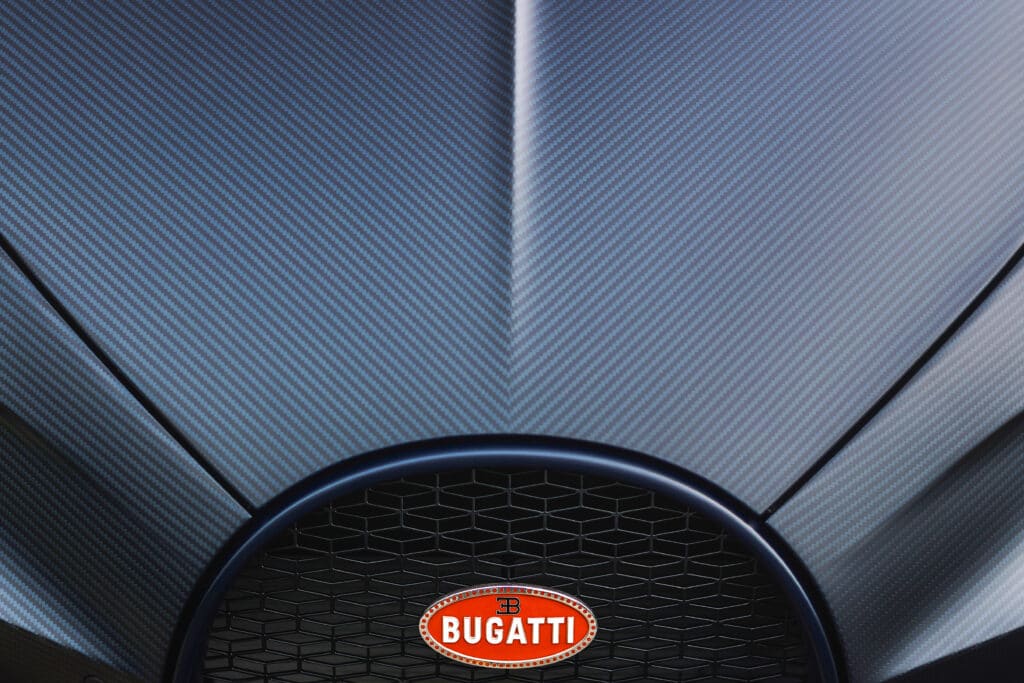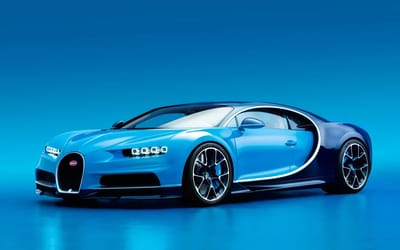Why are Bugattis so fast and what materials are they made from?
Published on Oct 17, 2023 at 5:57 PM (UTC+4)
by Amelia Jean Hershman-Jones
Last updated on Oct 19, 2023 at 1:57 PM (UTC+4)
Edited by
Amelia Jean Hershman-Jones
Whether it’s the Veyron, Chiron, one of the more limited models or whatever they come up with next – you know Bugattis are fast.
But what is it that makes Bugattis so fast?
From the powerful engine to the carbon-fiber frame, we break down what it is that sets Bugattis apart.
READ MORE! Kylie Jenner’s $6m car collection includes 7-figure Bugatti
The engine
The first thing behind Bugatti’s successful racing past is its engine power.
The company’s founder, Ettore Bugatti, made his first ever car, the Type 1, with four engines.
And Bugatti hasn’t stopped trying to build the fastest and most powerful cars ever since.
In August 2019, Bugatti topped the formerly reigning Hennessey Venom F5 with the Chiron Super Sport 300+.
The Chiron became the first car to break 300 miles per hour on the track.

The final record was 304.773 mph with racing driver Andy Wallace at the wheel on Volkswagen’s Ehra-Lessien test track in Germany.
What’s more, it can start from rest, accelerate to 400 km/h (250 mph) and decelerate to zero in under 42 seconds.
This makes it one of the most quickest productions cars ever made.
Its W16 engine produces 1,500 horsepower, it’s 16-cylinder, 8.0L 2-stage turbocharger is an engine to be reckoned with.
It weighs in at a whopping 1,000 lbs.
Their weight
But how are Bugattis so fast when they’re pretty big and bulky for their class?
The 1,000-lb engine alone accounts for almost a quarter of the entire car’s weight.
The truth is that their weight actually keeps them on the road.

If Bugattis weren’t so heavy as they are, the power of the cars would send a vehicle flying.
The two-seat Bugatti Chiron hypercar weighs a whopping 4,400 pounds, for example – only a fraction less than an eight-seat minivan.
The tires

The original Bugatti Chiron model was limited to a mere 261 miles per hour.
It wasn’t the car’s maximum speed but because tires strong enough to handle the pressure of going any faster hadn’t been invented.
When the Chiron Super Sport was released in 2019, Michelin took its Sport Cup 2 shoes and wove stronger metallic threads into the rubber.
Exhaustive testing at speeds of up to 317 mph were done before the shoes were fitted.
Each tire was then x-rayed after to find any imperfections.
This allowed the car to surpass the 300 miles per hour mark for the first time.
Temperature control
The Veyron has 10 radiators, and the same goes for the Chiron.
In the Veyron, three radiators handle the engine and three handle the intercoolers.
Then there’s one for air-conditioning, another modulating the engine oil, another cooling transmission oil and the tenth radiator cools the differential oil.
The radiator system takes 150 hours of labor to construct.
That’s A/C powerful enough to cool a 861 square feet apartment.
Carbon fiber

From the chassis to the body, Bugattis are mostly made of carbon fiber, because it is lightweight and incredibly strong.
The body panels are made carbon sheets that are thinner than a human hair, and stronger than any other fiber.
This explains why each panel takes a week to produce.
Carbon fiber body components weigh 20-30% less than a corresponding element made of aluminum or 50% less than steel., and this is without sacrificing resistance.
Bugatti claims that if all the individual strands of carbon-fiber in a Chiron were laid end-to-end, it would total 2,150,100 miles.
Imagine that.
That’s nine times the distance from the Earth to the moon or enough to wrap around the Earth 86 times.
DISCOVER SBX CARS: The global premium car auction platform powered by Supercar Blondie
All Supercar Blondie contributors undergo editorial review and fact-checking to ensure accuracy and authority in automotive journalism. After gaining her BA Hons in French and English at the University of Nottingham, Amelia embarked on a vocational diploma from the National Council for the Training of Journalists (NCTJ). This led to numerous opportunities, from interning at Vogue to being on the small team that launched Women’s Health magazine in the UK, which was named the PPA Consumer magazine of the year for three years running. As Health, Beauty and Fitness editor, Amelia personally received a Johnson & Johnson Award and was shortlisted for both PPA and BSME titles. Since then, Amelia has created content for numerous titles and brands, including the Telegraph, 111 Skin, Waitrose, Red magazine, Stylist, and Elle, as well as being Head of Content at Vitality and Editor in Chief at INLondon magazine. “My superpower is translating technical jargon about the mechanical workings of a supercar into a relatable story you’ll want to share with your friends after you’ve read it.” After joining the SB Media family as a senior journalist in September of 2023, Amelia’s role has evolved to see her heading up the SEO output of the editorial team. From researching the most ‘Google-able’ key terms to producing evergreen content - it’s been a time of hard work, growth, and success for the editorial team and the Supercar Blondie website. “I like to think of myself as a ‘method journalist’. In other words: I live and breathe whatever I am writing about. When writing about fitness, I trained as a personal trainer, and as a beauty editor, I completed an ‘expert’ in scent diploma with the Fragrance Foundation. “During my tenure at Supercar Blondie, however, I did something I never thought possible: I passed my driving test at the age of 36. One day I’d love to train as a mechanic to better understand what happens under the hood, too. “My sweet spot is providing readers with a ‘takeaway’ (read: something new they didn’t know before) after reading every one of my stories. While I don’t claim to be an expert in the automotive world, I know the experts and bodies in the field to rely on to provide our readers with an informative and thought-provoking story every time they visit the site.”





